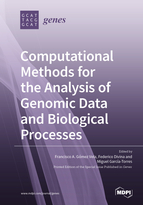Computational Methods for the Analysis of Genomic Data and Biological Processes
A special issue of Genes (ISSN 2073-4425). This special issue belongs to the section "Technologies and Resources for Genetics".
Deadline for manuscript submissions: closed (15 July 2020) | Viewed by 42769
Special Issue Editors
Interests: computer vision; machine learning; image and signal processing; 5G communications; IoT
Special Issues, Collections and Topics in MDPI journals
Interests: data mining; big data; artificial intelligence; soft computing; bioinformatics
Special Issues, Collections and Topics in MDPI journals
Interests: machine learning; bioinformatics; astrostatistics; big data
Special Issues, Collections and Topics in MDPI journals
Special Issue Information
Dear Colleagues,
In recent decades, new technologies have made remarkable progress in helping to understand biological systems. Rapid advances in genomic profiling techniques such as microarrays or high-performance sequencing have brought new opportunities and challenges in the fields of computational biology and bioinformatics. Such genetic sequencing techniques allow large amounts of data to be produced, whose analysis and cross-integration could provide a complete view of organisms.
As a result, it is necessary to develop new techniques and algorithms that carry out an analysis of these data with reliability and efficiency.
The aim of this Special Issue is to collect the latest advances in the field of computational methods for the analysis of gene expression data, and in particular with the modelling of biological processes.
We encourage researchers to share their original works in the field of computational analysis of gene expression data. Topics of primary interest include, but are not limited to:
- Computational methods or machine learning approaches for modelling biological processes;
- Discovering genome–disease or genome–phenotype associations;
- Gene–gene interactions and gene–environment interactions for disease association analysis;
- New computational methods for gene expression data analysis;
- Machine learning approaches for modelling gene regulatory networks;
- Identification of expression patterns;
- Reviews on computational methods for gene expression data analysis.
Update: A 2nd edition is being edited here https://www.mdpi.com/journal/genes/special_issues/comput_genetics_II
Prof. Dr. Francisco A. Gómez VelaProf. Dr. Federico Divina
Prof. Dr. Miguel García Torres
Guest Editors
Manuscript Submission Information
Manuscripts should be submitted online at www.mdpi.com by registering and logging in to this website. Once you are registered, click here to go to the submission form. Manuscripts can be submitted until the deadline. All submissions that pass pre-check are peer-reviewed. Accepted papers will be published continuously in the journal (as soon as accepted) and will be listed together on the special issue website. Research articles, review articles as well as short communications are invited. For planned papers, a title and short abstract (about 100 words) can be sent to the Editorial Office for announcement on this website.
Submitted manuscripts should not have been published previously, nor be under consideration for publication elsewhere (except conference proceedings papers). All manuscripts are thoroughly refereed through a single-blind peer-review process. A guide for authors and other relevant information for submission of manuscripts is available on the Instructions for Authors page. Genes is an international peer-reviewed open access monthly journal published by MDPI.
Please visit the Instructions for Authors page before submitting a manuscript. The Article Processing Charge (APC) for publication in this open access journal is 2600 CHF (Swiss Francs). Submitted papers should be well formatted and use good English. Authors may use MDPI's English editing service prior to publication or during author revisions.
Keywords
- Computational biology
- Bioinformatics
- Genomics
- Gene expression
- Gene regulation
- Biomarker discovery
- Gene network
- Biomedical data analysis









